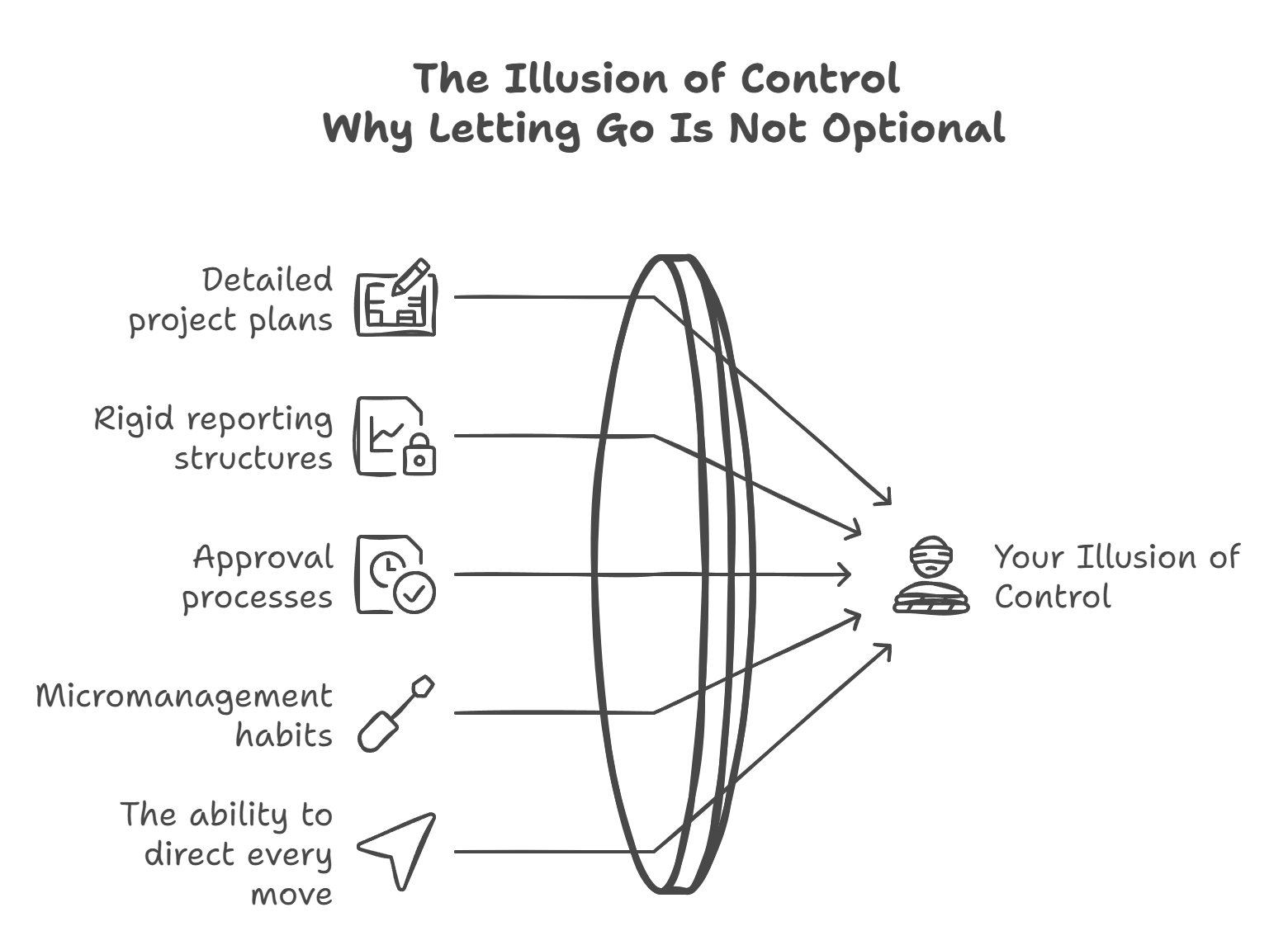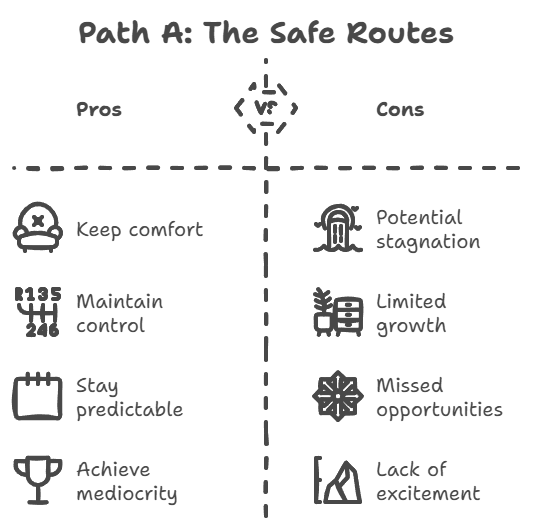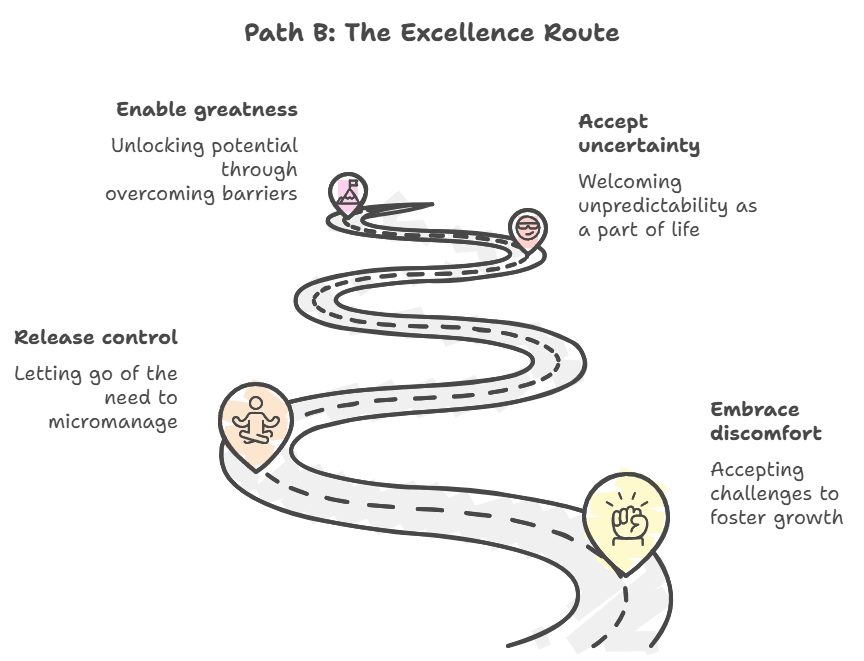The Uncomfortable Truth About Leadership Sacrifice
“If you want something you’ve never had, you must be willing to do something you’ve never done.”
– Thomas Jefferson.
Let’s get brutally honest about what it really means to build a high-performing team. This isn’t about writing bigger checks or investing in more training programs. The real price is far more personal – and far more painful.
1. Your Comfort as a Leader
What You Must Give Up:
- The luxury of being the smartest person in the room (tip: even if you are, you’re not. Tip 2: even if you are, don’t say it”)
- The satisfaction of having all the answers (hey, big head, you don’t have all the answers, so don’t play on that card. Instead, ask better questions. Questions lead to insights, and ideas change your inner world. With better insights, you manifest them to your outer world and change in the process. )
- The comfort of predictable days; because there is no such thing as a predictable outcome in business. With all those little intricacies, “moving parts”, challenges, and strategic options, you can’t have days off or play it on the card of predictability.
- Safety to maintain the status quo. Our world is changing at a rapid speed. We change as a result. A wise man says: “You don’t solve today’s problems with yesterday’s logic and last decade’s tools”. Special note – I want more wisdom.
What It Really Means:
- Watching your team make decisions that make you nervous: This means that you have confidence in your team’s abilities, even when you don’t agree with their decisions. It also means that you’re willing to give them the space to make mistakes and learn from them.
- Staying silent when you desperately want to jump in: This means that you’re respecting your team members’ autonomy and allowing them to take ownership of their work. It also means that you’re confident that they’ll make the right decision, even if it’s not the one you would have made.
- Supporting decisions, you wouldn’t have made: This means that you’re putting the team’s success ahead of your own ego. It also means that you’re willing to trust your team members’ judgment and accept that they may have a different perspective than you.
- Defending your team’s failures to your superiors: This means that you’re taking responsibility for your team’s actions, even when they don’t turn out as planned. It also means that you’re willing to stand up for your team and protect them from criticism.
Real Example: When Satya Nadella took over Microsoft, he had to give up the comfortable “Windows first” strategy that had defined his entire career. It was uncomfortable, scary, but it worked.
2. Your Illusion of Control
What You Must Give Up:
- Detailed project plans
- Rigid reporting structures
- Approval processes
- Micromanagement habits
- The ability to direct every move
Today’s ever-changing business environment forces many leaders to cling to the illusion of control, believing they can control, influence, be a part of it, or micromanage every aspect of their projects and teams. This illusion is not only counterproductive but also stifles innovation and agility. To achieve true success as a leader, you must be willing to let go of some of their traditional notions of control and embrace a more flexible and collaborative approach.

The Illusion of Control – Why Letting Go is Not Optional
Here are some specific things that leaders must give up to break free from the illusion of control:
- Detailed project plans: While having a general roadmap for your projects is essential, trying to plan every detail in advance is unrealistic and counterproductive. Instead, focus on creating a high-level plan that outlines the key milestones and deliverables. This will give your team the flexibility to adapt to changing circumstances and develop innovative solutions.
- Rigid reporting structures: Traditional reporting structures can be bureaucratic and time-consuming, slowing down decision-making and hindering collaboration. Instead, adopt a more agile approach to reporting, with regular check-ins and updates that allow for open communication and feedback. This will help your team stay on track and make necessary adjustments along the way.
- Approval processes: Approval processes can be a major bottleneck, especially in large organisations. To streamline decision-making and empower your team, consider delegating approval authority to the people closest to the work. This will speed up the process and free up your time to focus on more strategic issues.
- Micromanagement habits: Micromanaging your team will only stifle their creativity and initiative. Instead, trust your team members to do their jobs and provide them with the resources and support they need to succeed. This will foster a culture of empowerment and accountability, leading to better results.
- The ability to direct every move: As a leader, you can’t be everywhere at once. Trying to control every aspect of your team’s work will only lead to burnout and frustration. Instead, focus on setting clear goals and expectations, and then give your team the autonomy to achieve them in their own way. This will allow you to focus on the big picture and make strategic decisions that will drive your organisation forward.
“Your competitors thank you for your careful, methodical, by-the-book approach to innovation. They particularly enjoy the 18-month approval process for new ideas. Please don’t change a thing.”
Letting go of the illusion of control is not easy, but it is essential for leaders who want to create a high-performing team and achieve sustainable success in the modern business landscape.
Embrace collaboration to drive innovation. Unlock potential by allowing different perspectives, ideas and contributions.
What It Really Means:
- Accepting that chaos is part of creativity:
- Recognizing that the creative process is often messy and unpredictable.
- Embracing the idea that chaos can be a catalyst for new ideas and solutions.
- Being comfortable with not having all the answers and allowing yourself to be surprised by the unexpected.
- Trusting your team when everything looks messy:
- Believing in the abilities of your team members and their ability to contribute to the project’s success.
- Letting go of the need to micromanage and allowing your team the freedom to do their work.
- Communicating regularly with your team and providing them with the support they need to be successful.
- Letting go of knowing exactly what everyone is doing:
- Recognizing that it is impossible to control every aspect of a project.
- Trusting that your team members are capable of making good decisions and taking initiative.
- Empowering your team to make decisions without needing your approval.
- Embracing uncertainty as a feature, not a bug:
- Accepting that there will always be some uncertainty in any project (Because that’s the living, my friend. No certainties…)
- Being comfortable with not having all the information and making decisions based on the best available data (my tip: don’t collect the information; collect memories, create experiences, drive progress)
- Viewing uncertainty as an opportunity to learn and grow.
A real Example to think about is when Google allowed engineers to spend 20% of their time on side projects; they gave up control of 1/5 of their most expensive resources. The result? You know, all those “can’t-live-without-it” tools and programs like Gmail, Google News, and AdSense.
“Great leaders don’t climb mountains – they guide others to the summit. Your finest moment isn’t reaching the peak alone, but watching your team discover views they never thought possible.”
3. Your Predictable Metrics
What You Must Give Up:
- Easy-to-measure KPIs
- Clean performance reviews
- Neat quarterly forecasts
- Linear progress tracking
What It Really Means:
- Accepting that breakthrough innovation is messy: Innovation doesn’t follow a linear path. It involves taking risks, experimenting, and learning from failures. Embracing the messiness of innovation allows organisations to foster a culture that values creativity and experimentation.
- Measuring learning and attempts instead of just outcomes: Focusing solely on outcomes can stifle innovation. Instead, organisations should measure the learning and attempts that went into the innovation process. This encourages teams to take risks and try new things, even if they don’t immediately lead to success.
- Defending “failed” experiments to stakeholders: It’s essential to communicate the value of “failed” experiments to stakeholders. These experiments provide valuable learning opportunities and insights that can inform future innovations. By defending these experiments, organisations demonstrate their commitment to long-term innovation.
- Celebrating effort over results: Recognizing and celebrating the effort put into innovation, regardless of the outcome, is crucial. This motivates teams to continue innovating and taking risks, knowing their hard work will be valued. By celebrating effort, organisations create a positive and supportive environment for innovation to thrive.
Revisit the story of Amazon and its early beginnings. It all started when Amazon’s Jeff Bezos had to convince shareholders to accept years of unpredictable metrics and negative profits while building what would become AWS. Most leaders wouldn’t survive that uncertainty. Bezos, instead, invested in Amazon’s ecosystem, built the network and went for control, long-term dominance and unmatched service. The rest is history.
4. Your Reliable Quarterly Reports
What You Must Give Up:
- Steady, predictable growth
- Safe, achievable targets
- Conservative estimates
- Risk-free projections
What It Really Means:
- Accepting wildly variable results
- Defending periods of apparent non-performance
- Explaining why stability isn’t always good
- Trading short-term reliability for long-term breakthrough potential
Real Example: Tesla’s quarterly reports are famously volatile. Elon Musk gave up the stability most auto manufacturers prize for the chance at revolutionary change.
5. Your Safe Corporate Narrative
What You Must Give Up:
- The image of the all-knowing leader
- The comfort of traditional success stories
- The safety of conventional wisdom
- The protection of industry standards
What It Really Means:
- Being vulnerable about failures:
- Sharing your mistakes openly with your team, rather than trying to hide them.
- Acknowledging when you don’t know something and asking for help.
- Being willing to learn from your mistakes and grow as a leader.
- Admitting you’re learning alongside your team:
- Recognising that you don’t have all the answers and that you’re constantly learning new things.
- Being open to feedback from your team members and willing to adjust your approach based on their insights.
- Creating a culture of continuous learning and improvement within your team.
- Standing apart from industry norms:
- Challenging the status quo and questioning traditional ways of doing things.
- Being willing to experiment with new ideas and approaches, even if they’re unconventional.
- Having the courage to be different and to set your team apart from the competition.
- Risking your professional reputation:
- Putting yourself out there and sharing your ideas, even if you’re not sure how they’ll be received.
- Being willing to take calculated risks and to push the boundaries of what’s possible.
- Having the confidence to stand by your convictions, even if it means going against the grain.
Real Example: When Netflix announced they were moving from DVDs to streaming, they sacrificed their safe, successful narrative for an uncertain future. It temporarily tanked their stock but revolutionised entertainment.
The Hidden Costs Nobody Talks About
Beyond these visible sacrifices, there are deeper prices to pay:
- Your ego (when your team outsmarts you)
- Your relationships (with peers who don’t understand)
- Your certainty (about everything you thought you knew)
- Your identity (as the person with all the answers)
Why Most Leaders Won’t Pay This Price
The truth is, most leaders will read this and:
- Agree intellectually
- Commit emotionally
- Fail to execute practically
Let me explain, they will:
- Agree Intellectually: They will nod their heads in agreement with the concepts presented. They will understand the importance of leading with authenticity, empathy, and vulnerability. They may even share the article with their teams or post it on social media.
- Commit Emotionally: Some leaders will be moved by the message on an emotional level. They will feel inspired and motivated to make a change in their leadership style. They may even shed a tear or two as they reflect on their own experiences.
- Fail to Execute Practically: Despite their intellectual and emotional commitment, most leaders will fail to execute the principles consistently in their daily actions. The price of authentic leadership is simply too high for them to pay.
Why is this the case?
The price of authentic leadership is not theoretical – it’s intensely personal. It requires leaders to:
- Be vulnerable: Authentic leaders are not afraid to show their true selves, even when it makes them feel uncomfortable. They are willing to share their strengths and weaknesses, their hopes and dreams, and their fears and insecurities.
- Be empathetic: Authentic leaders can put themselves in the shoes of others and understand their perspectives. They are able to listen actively, ask open-ended questions, and show genuine concern for the well-being of their team members.
- Be courageous: Authentic leaders are not afraid to stand up for what they believe in, even when it’s unpopular. They are willing to take risks, challenge the status quo, and make tough decisions.
“Lead like water – find the lowest point, create the path forward, and lift everything around you. And like water, be transparent enough that people see their own reflection in your leadership.”
The price of authentic leadership is high because it requires leaders to confront their own fears, insecurities, and weaknesses. It requires them to be vulnerable, empathetic, and courageous. This is not easy, and it’s why most leaders won’t pay the price.
But for those who are willing to pay the price, the rewards are enormous. Authentic leaders are more effective, more respected, and more loved by their teams. They create cultures of trust, innovation, and high performance. And they leave a lasting legacy that inspires others to be their best selves.
The Real Question Isn’t “Can You Pay?”
The real question is: “Can you afford not to?”
Consider:
- What’s the price of maintaining control in a world of constant disruption?
- What’s the cost of predictability in an age of innovation?
- What’s the risk of playing it safe when your industry is being revolutionised?
The Decision Point
You stand alone at a crossroads. This is your moment of truth, and you must take a stand.
You must pick the road and engage the team to follow you. This is your time; you really have two options:
Path A: The Safe Routes
- Keep your comfort
- Maintain control
- Stay predictable
- Achieve mediocrity

Path B: The Excellence Route
- Embrace discomfort
- Release control
- Accept uncertainty
- Enable greatness

Your Journey To Excellence
The Decision Point
You stand at a crossroads where your choice will determine your life’s trajectory. Path A, the Safe Route, offers the allure of comfort, control, and predictability. Path B, the Excellence Route, challenges you to embrace discomfort, release control, and accept uncertainty but promises the potential for greatness.
Path A: The Safe Route
Choosing Path A means opting for a life of mediocrity. You cling to your comfort zone, unwilling to venture into the unknown. You maintain a tight grip on control, fearing the consequences of letting go. Your life becomes predictable, devoid of surprises or growth. You achieve mediocrity, never reaching your full potential.
- Keep Your Comfort: You prioritise comfort above all else, avoiding challenges that might disrupt your routine. You become stagnant, lacking the motivation to push yourself beyond your limits.
- Maintain Control: You tightly control every aspect of your life, micromanaging situations to ensure they unfold according to your plan. Your need for control stifles creativity and innovation.
- Stay Predictable: You follow a well-trodden path, avoiding risks and deviations. Your life becomes monotonous, lacking excitement or adventure. You miss out on opportunities to learn and grow.
- Achieve Mediocrity: Your fear of failure and desire for comfort prevent you from aiming high. You settle for mediocrity, never reaching your true potential. You become complacent, accepting your limitations without question.
Path B: The Excellence Route
Choosing Path B is not for the faint-hearted. It requires courage, resilience, and a willingness to step outside your comfort zone. You embrace discomfort as a necessary part of growth, knowing that it is only through challenges that you can truly evolve. You release control, trusting that the universe has a plan for you. You accept uncertainty, knowing that it is an inherent part of life. And through these choices, you enable greatness within yourself.
- Embrace Discomfort: You actively seek out challenges and opportunities that push you beyond your limits. You understand that growth happens outside of your comfort zone and are willing to face discomfort to become the best version of yourself.
- Release Control: You let go of the need to control every aspect of your life, trusting that the universe has a plan for you. You surrender to the flow of life, allowing unexpected opportunities and experiences to come your way.
- Accept Uncertainty: You embrace the unknown, knowing that it is an inherent part of life. You learn to navigate uncertainty with grace and agility, making decisions based on your values and beliefs rather than fear.
- Enable Greatness: By choosing Path B, you awaken your potential for greatness. You set ambitious goals, push yourself to the limits, and never settle for mediocrity. You inspire others through your dedication and achievements, leaving a lasting impact on the world.
The decision point is yours, and the choice you make will shape your destiny. Will you choose the Safe Route, where comfort and control reign supreme, or will you dare to embrace the Excellence Route, where discomfort, uncertainty, and greatness await? The choice is yours.
The Final Truth
Excellence isn’t expensive – it’s painful. The price isn’t measured in dollars but in personal sacrifice.
“The only real mistake is the one from which we learn nothing.”
– Henry Ford
The question isn’t whether you can afford to pay the price of excellence.
The question is: Can you live with the price of mediocrity?
What will you choose?

